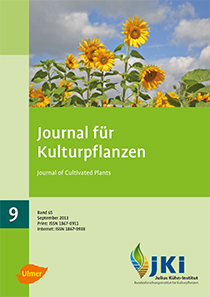First report on herbicide resistance of Wild Oat (<em>Avena fatua</em> L.) in Germany
DOI:
https://doi.org/10.5073/JfK.2013.09.03Keywords:
Avena fatua, ACCase, ALS, Fenoxaprop, Pinoxaden, Clodinafop Pinoxaden, Cycloxidim, IodosulfuronAbstract
Two seed samples of Wild Oat (F1, F2) were collected from sugar beet fields in Rhineland-Palatinate in 2011 showing reduced herbicide performance. A seed treatment with gibberellic acid improved uniform germination of the Wild Oat samples during greenhouse experiments. Herbicide action was tested by means of two successive biotests. ACCase-inhibitors (Fenoxaprop, Pinoxaden, Clodinafop+Pinoxaden, Cycloxidim) and one ALS-inhibitor were treated at 2–3-leafstage of the Wild Oat. The visual rating of herbicide efficiency 3 and 4 weeks after treatment showed a cross resistance among the tested ACCase-inhibitors, except for Cycloxidim for both samples. Seed sample F2 revealed an advanced degree of herbicide resistance, declining from Fenoxaprop to Pinoxaden. Herbicide resistance of sample F1 was restricted to single plants. A subsequent genetic analysis of leaf material revealed a target-site mutation I1781L for both samples of Wild Oat.
Further investigations are necessary in order to access reduced performance of Iodosulfuron.
Downloads
Published
Issue
Section
License
The content of the journal is licensed under the Creative Commons Attribution 4.0 License. Any user is free to share and adapt (remix, transform, build upon) the content as long as the original publication is attributed (authors, title, year, journal, issue, pages).
The copyright of the published work remains with the authors. The authors grant the Journal of Cultivated Plants, the Julius Kühn-Institut and the OpenAgrar repository the non-exclusive right to distribute and exploit the work.







